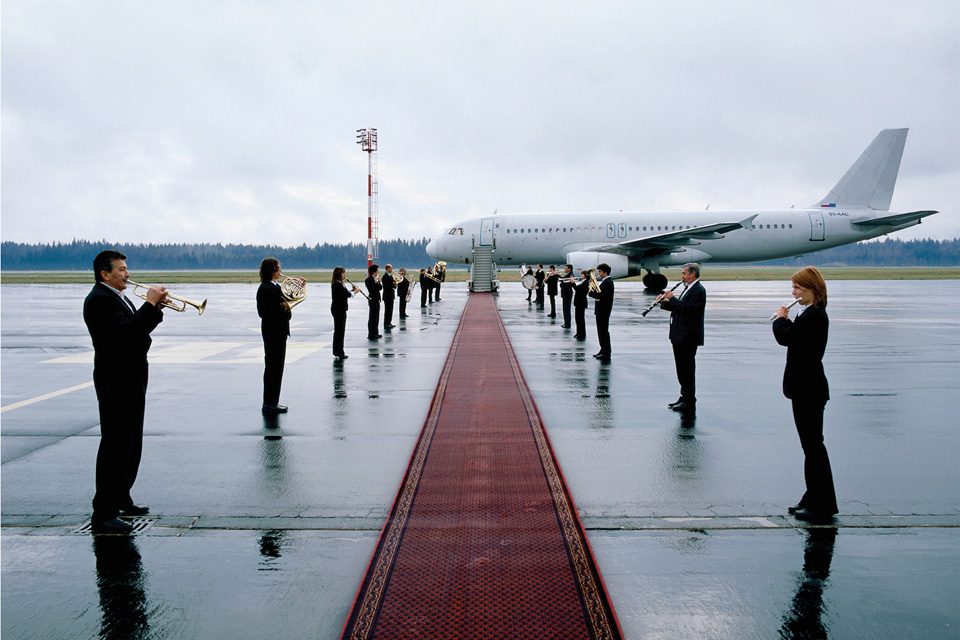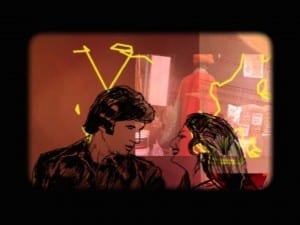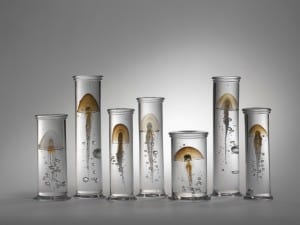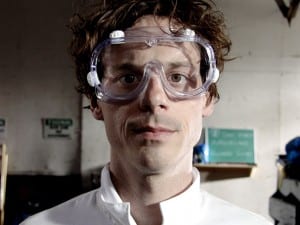Creating a distinct visual language of her own, Jasmina Cibic represents the Slovenian Pavilion at Venice this year with For our Economy and Culture.
The Venice Biennale is the world’s foremost showcase for art from around the globe, with countries and their pavilions representing a specific view of their nationality and artistic output in an international setting. In separating its works by country, and creating discrete pavilions, the Biennale model assumes some representation for each country’s artists’ practice. This year’s Slovenian Pavilion shows the work of Jasmina Cibic (b. 1979), part of a growing contingent of artists who recognise the preconceptions and pressures of being a former Eastern Bloc artist and are working with these stereotypes to interrogate nations’ representations of themselves.
Cibic’s presentation at Venice provides a serendipitous opportunity for the artist to further her work, and investigates the use and representation of space for political ends. Rather than seeing her pieces for the Biennale as performing under a certain pressure to represent her country at such a high profile event, she sees her work as “utilised in a very specific way and [with] a very defined role; one that is not in the least determined by me. It would be both naïve and counterproductive to have any illusions that I could avoid the mechanisms that shape the meaning structure of the Venice Biennale. As soon as you participate, you automatically become part of the mechanism.” In undertaking projects as part of the country’s representation, Cibic recognises that the work inherently becomes institutionalised and that her role offers an opportunity to examine these tropes of representation from within. She says: “I not only ‘accept’ my role as national representative but I actually over-identify with it, embracing its inescapable dynamics and utilising its modus operandi to my advantage in order to articulate my own critique from the position of an embedded auteur.”
With Slovenia’s socialist history, Cibic emphasises the “elaborate selection process” of becoming this year’s Biennale artist, and the attached rigmarole of requiring gallery representation. The gallery will then forward the project to the Ministry of Culture for deliberation, and the final conclusion is made by the Cultural Minister. This process, however, is inherently linked to the heart of her practice, which is why her selection is particularly apt, she comments: “Paradoxically, it is exactly this whole state-run decision-making apparatus, with all of its subtle and hierarchical mechanisms, that lies at the core of my Biennale project. For our Economy and Culture investigates the ideology-ridden processes of selection that define national iconographies; that underpin the creation of national icons and create a further visual framework of national identification. To be selected as the representative of Slovenia therefore places me in an ambivalent but highly interesting position: on the one hand being instrumentalised as a tool of national recognition and promotion; on the other having a privileged perch, enabling me as an artist to study, close at hand, the ideological structures of producing an ‘orderly’ visual image of state.”
Cibic’s piece, For our Economy and Culture, is a multimedia installation that inhabits the Slovenian Pavilion and evaluates the space to engage with the artist’s representation and reading of Slovenia. Operating within the confines of the A+A Gallery, a “re-purposed private residence” that holds the Slovenian Pavilion each year, Cibic worked with the small, intimate space to develop a project “that didn’t fight the diminutive space but rather worked with it, emphasising its nature”. The architecture of the space itself directly influenced Cibic’s work, and led her to continue the ongoing interrogations of her practice into how governments appropriate architectural spaces to their own ends. “I worked in collaboration with the architect Mateja Šetina to reconstitute the architectural methodologies used by Vinko Glanz. Glanz was the main State architect during Josip Broz Tito’s era in post World War II Yugoslavia. His role was to redesign protocol for official architecture and make it relevant for a new state … Glanz observed local craftsmanship and building materials, and employed national artists to support his work. A trademark of his style, developed out of the Vienna School in 1910, was to utilise marble and wooden cladding but leave walls empty and uncluttered. By employing methods that helped designate the scenography for the new nation state, I wanted to turn the Pavilion itself into a space of state representation. Part of the ‘ornamentation’ involves a selection of flower paintings drawn directly from the Slovenian Parliament’s Official Art Collection. These paintings usually hang in the parliamentary offices and reflect the floral centrepieces that traditionally decorate conference tables.”
These flower artworks directly engage with everyone’s perceptions of different art forms and subject matter as inherently possessing gendered and political implications: “A still life or flower arrangement is characterised as decorative, passive and non-threatening precisely because of the ideological mechanisms at work, giving it a certain surplus of meaning. And that is what For our Economy and Culture is trying to identify: the inherent ideological grinding that instrumentalises an artwork. The still lifes I utilise don’t become political because of my rendering; I just amplify the fact that their categorisation as feminine or purely decorative is already the result of certain political mechanisms at play, and I am only trying to crystallise the process of their ideological position.” In using these state-owned works, Cibic hopes to “make the spectator more aware of their purpose and to question the choices of such images as well as their position and meaning. ”
Although the paintings are taken from government collections, and implicitly highlight the use of such “neutral” and “non-confrontational” subject matter in decorating government offices, Cibic points out that the selection of paintings for the Pavilion was completely independent of government. She and the curator, Tevz Logar, chose which paintings to include and Cibic argues that “the choice to use these ‘decorative’ paintings is by no means an attempt to attack or mock the Parliamentarians personally. It’s an investigation into how artworks are chosen to represent a certain idea of the State and how ideological ambition ‘interferes’ with the work of art, making this interference a key component of the artwork’s identity.”
Cibic’s piece relates directly to her previous practice, which has focused on “exposing the grid in which our reality is presented.” Her work sees intervention into what Marc Augé referred to as “non-places”, and sites Cibic characterises as “the passive, meaning-devoid, ideologically unburdened spaces like transit lounges and waiting rooms, which we pass through without acknowledgment, since they have no identity.” Crucially, for her, it “involves investigations into the actual architectural framework of spaces and their ability to create an ideological effect, directing our gaze and the way we experience and construct reality.” Therefore, “the context of the Biennale and the unorthodox spatial set-up and history of the Slovene Pavilion were key elements in providing a fresh but entirely appropriate context to redefine previous concerns.” Ultimately Cibic wants to “build upon well-documented episodes from the history of early socialist Yugoslavia, but [the works] are by no means historical. They reconstruct the selection processes that decided what was the most ‘appropriate’ art and architecture to propagate the values of the newly established socialist state.”
For our Economy and Culture also incorporates two film pieces into the space – Framing the Space and Fruits of Our Land – both of which “anticipate and subvert expectations around fact and fiction in national myth-making.” Framing the Space again references the centrality of architecture, and of state architect Vinko Glanz’s work in manipulating the form to represent the communist regime. It is shot at Tito’s residence in Lake Bled, “where he received royalty and state dignitaries in post World War II Yugoslavia”, and “dramatises a conversation between Glanz and a journalist around strategies of state architecture.” For Cibic the time was just as important as the place in filming: “It was shot on the exact day, 55 years later, that the first meeting concerning the decoration of the National People’s Assembly was held. The shoot also happened to fall on the same day as the Republic of Slovenia reclaimed the building from tenants who had been running it as a hotel since Tito’s death.” Symbols of power and remnants of a particular place are highlighted under Cibic’s camera. She says: “I included ‘souvenirs’ from the golden age of Vila Bled: a stuffed zebra donated to Tito by one of the countries that formed the Non-aligned movement and various sculptures that went on to decorate the portal of the National Assembly. They were brought in from depots and archive vaults, and appear as mere props in the film, foregrounding their original purpose as national scenography.”
The cinematography of Framing the Space also illustrates Cibic’s conversation with the conventions and aesthetic concerns of 20th century art. Since the 1950s, photographers have been preoccupied with the frame of the lens and how their images work within it, and these formal concerns are immediately apparent in Cibic’s use of filming as well as in her use of architecture: “There are numerous historical references in my work because the questioning of past strategies, formal or otherwise, is very much part of the content. And since I often deal with phenomena from the past, I cannot avoid engaging with particular formal artistic concerns that directly affect my work … It is vital for me that the frame is always connected to the space I am addressing, and I try to create a tension that plays with the viewer’s perception in connection to their individual knowledge and memory, as well as their intellectual, emotional or aesthetic experiences. Thus the specific formal concerns of framing an image have to become my own concern, since I would always ask what made them choose this particular expression or view instead of some other? What motivated their choice and therefore what should motivate mine?”
Cibic’s second film, Fruits of Our Land, “re-enacts word-for-word a parliamentary committee discussion of the ‘appropriateness’ of specific artworks proposed to decorate the People’s Assembly.” It was shot at the Slovenian Parliament, and Cibic uses this exact setting, and an accurate transcription of the original debate, to highlight the timelessness of the ongoing argument (on which her work has long been focused). “The debate took place in 1957 but it cannot be experienced as purely a historical reconstruction, since it could easily – and eerily – be mistaken for a current debate around cultural selection processes. Interestingly, the transcript of this debate was actually found abandoned in a dank garage within a shopping trolley filled with the archives of the former Yugoslav state architect. It is not recorded in any official state archives as far as our research has discovered. The film is presented in a continuous loop, so it appears to be a neverending meeting of committee members carrying on a discussion that never resolves itself.”
For Cibic it was important that both of these films should be presented as re-enactments rather than as straightforward documentaries because the re-enactment makes them more relevant to the issues of today, specifically here and now: “It is precisely by connecting a seemingly localised historicism with the current contemporary moment that I hoped to accentuate the constant and universal mechanisms that dictate how we present (or don’t present) a nation.” She goes on to emphasise: “As part of my project is about exploring the consequences of the backfiring of attempted national branding, it was important to go back to archival material and scrutinise the non-presence of certain events and icons within them. It’s a way of getting behind the scenes of selection processes and exposing the cracks and flaws within the smooth well-oiled machine that nations have brandished almost like a shield to position and convey an identity throughout the 20th and 21st century.” Ultimately, Cibic highlights the perpetual importance placed on a view of nationhood in contemporary art.
Jasmina Cibic’s For our Economy and Culture runs 1 June until 24 November at the Slovenian Pavilion as part of the 55th Venice Biennale. For further information, please visit www.slovenianpavilion.net.
Ruby Beesley





